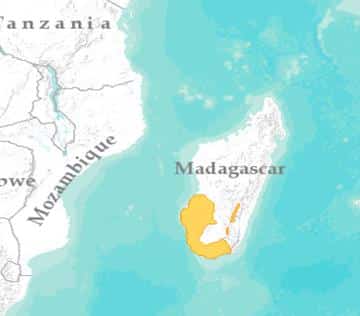Ring-tailed Lemur (Lemur catta)
Habitat:
Ring-tailed Lemurs inhabit deciduous, montane, gallery forests (along riverbanks) or dry scrub areas in South and South-western Madagascar.
Description:
Ring-tailed Lemur’s have black skin covered mostly by grey fur, their tails have a fur pattern of alternating black and white rings. They have bright yellow or amber eyes surrounded by mask-like black skin and opposable big toes for life in the trees. Both male & female Ring-tailed Lemurs measure up to 95-110cm (tail tip to nose) long and weight roughly 2.2kg.
Status:
Endangered
Interesting facts:
- Lemur comes from the Latin word ‘lemurs’ meaning ghost, given due to their ghost like appearance, noiseless movements at night, reflective eyes and ghostly cries.
- Diet: fruits and leaves particularly from the Tamarind tree, flowers, herbs, bark, sap, spider webs, insect cocoons, spiders, caterpillars, cicadas, grasshoppers and small vertebrates
- Reproduction: Breeding season typically runs from mid-April to mid-May, in this time females within the group stagger their receptivity to prevent competition for male attention and mate with more than one male in the group.
- Gestation period: 130 days to normally one young but occasionally 2. Infants are carried ventrally (on the chest) for 1-2 weeks then dorsally (on the back).
- Lifespan: approximately 16-19 years in the wild and up to 27 years in captivity.
- Group Structure: The Ring-tailed Lemur lives in groups of up to 30 individuals and is female dominant, a trait common in lemurs.
- Native Predators: Fossa, Madagascar Harrier-Hawk, Madagascar Buzzard and the Madagascar Ground Boa. Introduced Predators: Indian Civet, Domestic Dogs & Cats.

Ring-tailed Lemur Population Distribution Map






